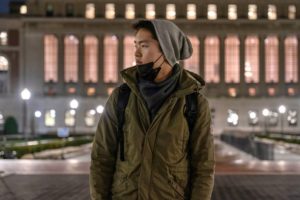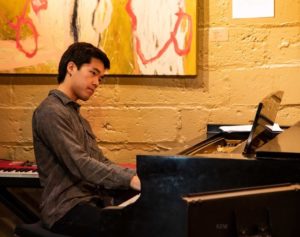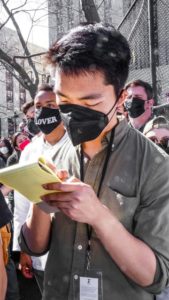Through the lens of Seiji Yamashita ’20, ’20E
Through the lens of Seiji Yamashita ’20, ’20E
A Japanese American journalist and jazz pianist

Seiji Yamashita ’20, ’20E
Seiji Yamashita took to the piano quickly at age 5. When he discovered his passion for jazz though at age 14, his teachers made it clear that playing this Black art form came with a responsibility. It wasn’t just about hitting the right notes or mastering a musical technique, it was about finding a voice deep inside that could express the music authentically, creatively, and originally.
Today, Yamashita continues to take that responsibility very seriously as a jazz pianist and a journalist who is focused on telling stories that give voice to the underrepresented and often unheard.
As a Japanese American whose parents were immigrants, jazz has always resonated with Yamashita. “Jazz is full of feeling, emotion, and purpose—it’s speaks a language that represents a community and resonates with so many people in that community and beyond it,” says Yamashita. “It’s given me an ideology and a lens through which to view the world. Journalism does that, too.”
Yamashita’s time at the University of Rochester—where he majored in international relations at the School of Arts & Sciences and jazz studies at the Eastman Music of School—gave him plenty of opportunities to explore his interests in politics, creativity, and community advocacy and engagement.

Yamashita at the piano
For instance, Yamashita wrote for the Campus Times. He was also part of a K-pop—short for Korean popular music—channel on YouTube. This was where mostly classically-trained Eastman students analyzed the compelling and very popular aspects of K-pop. Eventually that YouTube page accumulated 800,000 subscribers.
Yamashita became an AmeriCorps Urban Fellow, too, which gave him the opportunity to work at an enrichment camp for underserved youth the summer between his sophomore and junior years. He also performed every Sunday at Destiny Preparation Church, a non-denominational, multicultural place of worship on Lyell Avenue in downtown Rochester. He was the keyboard player in the church’s gospel band.
“All of these experiences helped me get to know the Rochester community—often parts of it that I wouldn’t have known without making the effort to get out there,” he says, noting that the importance of community engagement and service was instilled in him at a young age, through his parents and at his San Jose, California, high school.

Yamashita reporting from a NYC protest
These experiences gave Yamashita new perspective and shined a light on the struggles and joys of others—all of which were driving forces in his decision to pursue journalism. That wish to become a journalist led him to apply to Columbia University’s Graduate School of Journalism. A few months before his college graduation, Yamashita submitted his journalism school application and a few Campus Times stories. Just prior to commencement, he opened his acceptance letter from Columbia. He was thrilled.
So, after graduating from the University in 2020, Yamashita went straight to New York City. While attending Columbia’s one-year master’s program, Yamashita soaked in his journalism program and the Big Apple’s prolific jazz scene. And, he pursued telling the stories that were important to him—about race and class; about artists, musicians, and working-class people; and about the government and large systems that all too often leave people behind. This all happened during the pandemic, too.
“The number of hate crimes and protests held since the onset of the pandemic illustrates the need for more stories—and more compassion for—those who look and live differently,” Yamashita says. “I want my stories to help readers see that there are so many people out there who need to be treated better—it’s really as simple as that. Our world needs to do and be better.”
Learn more about Seiji Yamashita. Read more about research that University of Rochester’s computer and political scientists are doing with social media to drill down on anti-Asian hate crimes.
Videos
Medical Student Overcomes Trauma from Anti-Asian Attack
“There were—and are still—so many stories to tell about equality, including this one. Natty is a medical student who was called in to help hospitals during Covid. It’s shocking that someone wearing scrubs and a whitecoat would be attacked in an anti-Asian hate incident, but this, in fact, happened,” says Yamashita.
A Brooklyn HBCU Marching Band Thrives Despite the Pandemic
“This unique and highly energetic marching band came to life during the pandemic, with great leadership and lots of talent. They’ve done so much without a budget, too. Amazing. I can really relate to them, too—their jazz and gospel music really speaks to me.”
New Yorkers Speak Out in Response to Mass Shooting in Atlanta
“I produced this video in New York City’s Chinatown shortly after the Georgia shooting that killed eight Asian Americans. I had never seen so many people gathered here in Columbus Park before. The people weren’t angry either—they needed a place to be together and build community. This was a difficult and emotional yet important story to tell.”
Music
“Waltz for Debby,” composed by Bill Evans
“This is a transcription of a tune that I planned to play at my degree recital last March. Because of the pandemic though, my recital and everyone else’s had to be canceled.”
“Black Narcissus,” composed by Joe Henderson
“I wrote this arrangement several years ago during my first year at Eastman. It’s a song that I have always loved and writing an arrangement was a way to get more connected with the piece.”
“May,” composed by Seiji Yamashita
“I wrote this in 2018 when I was a member of AmeriCorps. When I listen back to the tune, I can’t help but notice some of the intangible qualities it has that reflect where I was emotionally at the time. The melody and harmony is very lyrical and beautiful, but it also has a more brooding energy and quality underlying the way the melody develops and oftentimes how the song develops during improvisation. I didn’t intend to write a song about ‘my feelings’ when I wrote down the melody. Rather, the song I was hearing in my mind at the time naturally came out this way and after the fact, its qualities have begun to make more sense.”
Stay connected with the University of Rochester. We’d love you to volunteer, attend an event, become a mentor, join a regional or affinity network, and celebrate traditions with us such as Meliora 2021 and milestones like Eastman’s Centennial. You’re part of our community because of your connection as a graduate, student, parent, or friend of the University. Meliora!
— Kristine Kappel Thompson, August 2021


